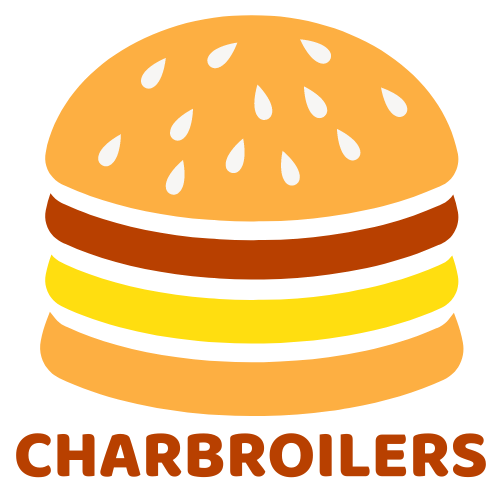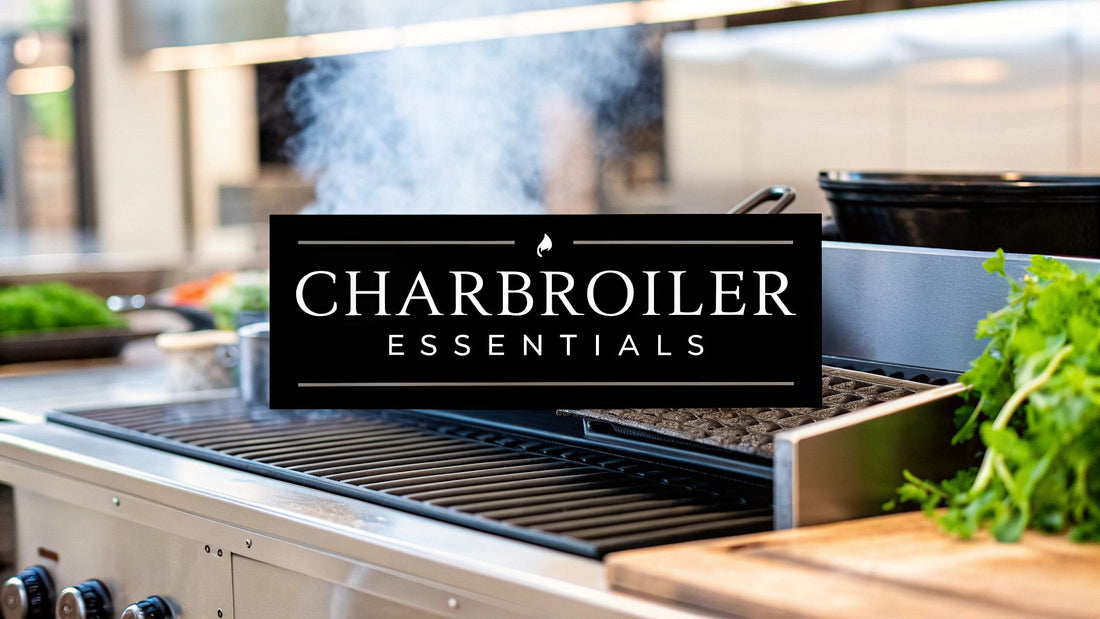
What is a Charbroiler? Essential Guide for Your Kitchen
Share
If you've ever wondered how to get that authentic, flame-grilled flavor inside a professional kitchen, look no further than the commercial charbroiler. It’s your restaurant's dedicated indoor BBQ, built to handle the intense demands of daily service while delivering the smoky taste and perfect sear marks that customers line up for.
This isn't your average backyard grill. A commercial charbroiler offers the kind of precise, repeatable control that's simply impossible to get with a standard setup.
Understanding The Commercial Charbroiler

So, what exactly makes a charbroiler the cornerstone of so many successful menus? Think of it as the ultimate tool for bringing genuine open-flame cooking indoors. Its core job is to blast intense, direct heat from below, cooking food on heavy-duty grates designed for professional use.
But here's where the real magic happens. As meat, fish, or vegetables cook, their natural juices and marinades drip down onto the hot source below—whether that's ceramic briquettes or metal radiants. These drippings instantly turn into flavorful smoke, which rises up and bathes the food in that unmistakable charbroiled essence. It's a flavor profile that you just can't get from a flat-top or a standard oven.
To give you a clearer picture, here’s a quick breakdown of what these workhorses do for a professional kitchen.
Charbroiler at a Glance
| Feature | Description | Primary Benefit for Restaurants |
|---|---|---|
| Heat Source | Intense radiant heat from gas, electric, or infrared elements below the cooking grates. | Creates authentic char and sear marks, just like an outdoor grill. |
| Cooking Grates | Heavy-duty cast iron or stainless steel grates that hold and transfer heat. | Delivers signature grill marks and supports heavy, continuous use. |
| Flavor Infusion | Drippings vaporize on the heat source, creating flavorful smoke that envelops the food. | Infuses every item with a distinct, smoky flavor that can't be replicated. |
| Temperature Control | Adjustable heat zones allow for precise cooking of different foods simultaneously. | Increases menu flexibility and ensures consistent results every time. |
Simply put, a charbroiler is an investment in your menu's most memorable dishes.
Different Types For Every Kitchen
Charbroilers have been a staple in kitchens around the world for ages, providing a simple yet effective way to cook over a series of heated grates. Today, this classic piece of equipment has evolved to meet the needs of modern restaurants. We offer a wide selection of commercial charbroilers for your restaurant, including powerful gas, efficient electric, and advanced infrared char broilers to match any menu.
The main types you'll find are:
- Gas Charbroilers: The industry workhorses, known for their raw power and ability to heat up fast. They're perfect for kitchens that need to handle a serious dinner rush.
- Electric Charbroilers: Praised for their dead-on temperature control and energy efficiency. These are a great choice for kitchens where consistency is the top priority.
- Infrared Charbroilers: These use advanced technology to cook food faster, sealing in moisture for juicier results and significantly cutting down on flare-ups.
Choosing the right charbroiler isn’t just about buying equipment; it’s about defining your menu's signature items. It’s what turns a good burger into the burger that people cross town for.
This gear is non-negotiable for any spot that prides itself on steaks, burgers, grilled chicken, or perfectly charred vegetables. If you're ready to learn more, getting fired up about commercial charbroilers is a fantastic place to start. This guide will set the stage for a deeper dive into picking the perfect model for your kitchen.
How a Charbroiler Creates Its Signature Flavor
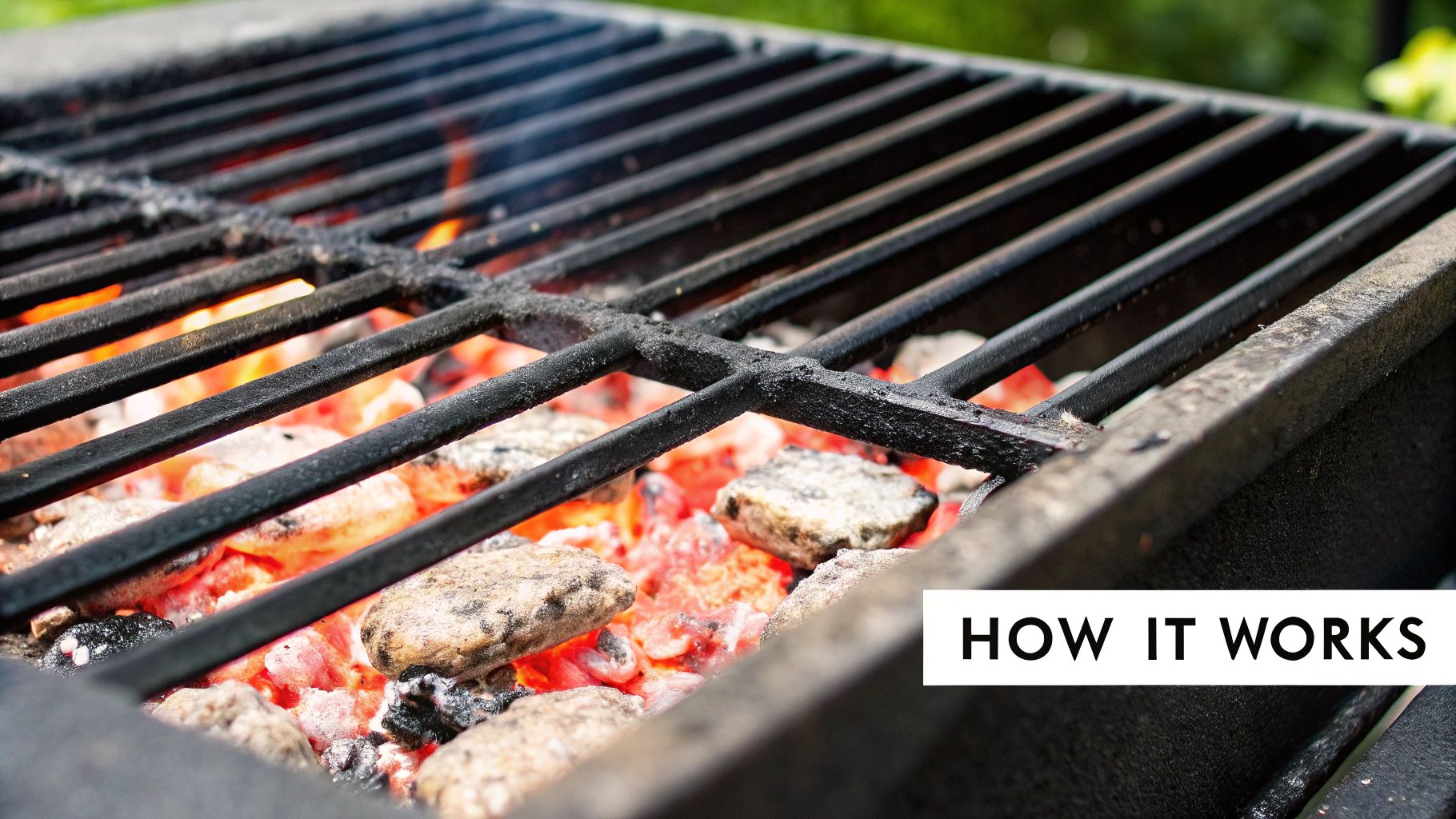
That incredible, smoky flavor you get from a commercial charbroiler isn't just about cranking up the heat. It’s a fascinating bit of flavor science playing out right on your cook line. While the intense, direct heat from the burners gets things started, the real secret to that authentic char-grilled taste comes from a dynamic interaction between the food and the charbroiler itself.
Picture a perfectly marinated steak hitting the hot grates. As it sizzles, juices and bits of marinade inevitably drip down. This is the magic moment, the exact point where a charbroiler proves it’s in a different league from any other cooking method.
Instead of just pooling or burning away, those drippings land on the scorching-hot components below—either angled metal radiants or porous ceramic briquettes. The instant they hit that surface, they vaporize into a plume of flavorful smoke. This smoke then rises and wraps itself around the food, infusing it with that deep, smoky charbroiled taste that you simply can't get from a flat-top or an oven.
The Role of Key Components
To really get what a charbroiler is, you have to appreciate how its parts work in concert. Two pieces of the puzzle are absolutely critical for wrangling the heat and creating that one-of-a-kind flavor profile: the grates and the radiants.
-
Cooking Grates: These are much more than just a shelf for your food. Forged from heavy-duty materials like cast iron, they absorb and transfer a massive amount of heat, creating those beautiful, picture-perfect sear marks customers love. The design of the grates also plays a role in channeling excess grease away, which is key to keeping the whole process under control.
-
Heat Shields and Radiants: Sitting directly above the flames, these angled pieces of metal or ceramic briquettes do double duty. They shield the burners from getting clogged by drippings, but more importantly, they are the vaporization platform. Their design is specifically engineered to spread heat evenly across the entire cooktop, fighting off nasty hot spots.
The essence of charbroiling is this continuous cycle: dripping, vaporizing, and smoking. This process repeats over and over during cooking, layering complex, smoky notes onto the food that become the hallmark of a great grilled dish.
Managing Flare-Ups and Keeping Things Consistent
This vaporization process is also your best friend when it comes to managing flare-ups. A little flame-kissed action looks great, but uncontrolled flare-ups will torch your food and leave it with a bitter, acrid taste. The heat shields are designed to deflect most of the grease into a collection tray below.
This controlled system ensures just enough drippings hit the hot surfaces to create flavor without turning into a dangerous grease fire. It gives chefs the confidence to cook with high, direct heat while still maintaining precise control. The result is consistently cooked food with a beautifully charred exterior and a juicy, tender interior—the very reason restaurants invest in high-quality commercial charbroilers. When you understand this process, you see how the equipment itself is an active partner in creating amazing flavor.
Choosing the Right Heat Source for Your Kitchen
Picking the right heat source for your commercial charbroiler is a huge decision. It's not just about what fuel you use; it's a choice that ripples through your whole operation, affecting cook times, flavor, your kitchen's workflow, and even your monthly utility bills. The decision between gas, electric, or infrared will literally shape the signature taste of your grilled dishes.
Think of it this way: a high-volume steakhouse has completely different needs than a small café that grills chicken for salads. Getting this choice right from the start is the first step to setting your kitchen up for success. We carry a wide selection of commercial charbroilers to make sure there’s a perfect fit for whatever you're cooking.
H3: Gas Charbroilers: The Industry Standard
When you need raw power and an instant response, nothing beats a classic gas charbroiler. These are the undisputed workhorses of the commercial kitchen, the go-to choice for bustling steakhouses and busy burger joints where speed is everything. Chefs absolutely love them for their quick heat-up times and the powerful, on-demand flame they deliver.
That fast response lets a cook pivot on a dime, going from a blistering sear to a low holding temperature with just the turn of a knob. That kind of control is a lifesaver during a chaotic dinner rush.
Gas models hook right into your restaurant's natural gas or liquid propane line. This fuels a potent, consistent flame that heats the radiants or briquettes, creating that deep, smoky char that customers crave and associate with authentic grilling.
H3: Electric Charbroilers: Precision and Efficiency
Electric charbroilers are the champions of consistency. While they might take a few extra minutes to preheat compared to gas models, their superpower is maintaining a perfectly even temperature across the entire cooking surface. This makes them a fantastic choice for kitchens where consistency is key, or for locations where running a gas line just isn't an option.
These units really shine when you’re cooking more delicate items like fish or poultry. The precise temperature control helps prevent overcooking, ensuring you get a moist, tender product every single time. As a bonus, since there's no open flame, electric models can lead to a cooler kitchen and are often simpler to install without needing as much heavy-duty ventilation. We have a great lineup of electric char broilers designed for the modern kitchen.
To get a better sense of these trade-offs, this chart shows a great comparison of key performance metrics for different grill types.
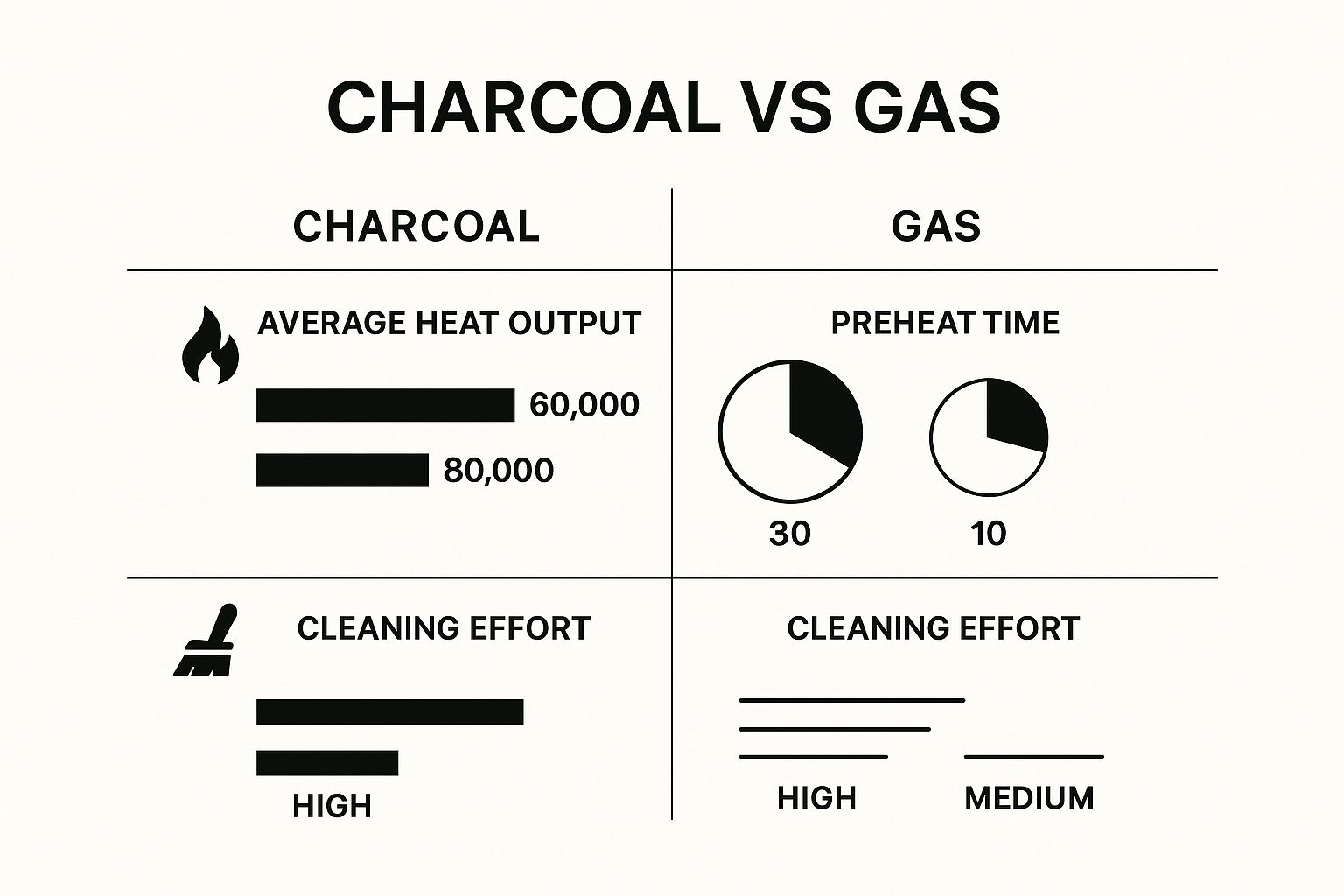
The data makes it clear: while one fuel source might win on preheat speed, others have their own unique strengths. This same principle applies perfectly when you're comparing gas, electric, and infrared charbroilers.
To help you weigh the pros and cons directly, here’s a quick-glance table breaking down the key differences between the three main types of charbroilers.
Gas vs Electric vs Infrared Charbroilers
| Feature | Gas Charbroiler | Electric Charbroiler | Infrared Charbroiler |
|---|---|---|---|
| Heat-Up Time | Very fast (5-10 minutes) | Slower (15-20 minutes) | Extremely fast (2-5 minutes) |
| Temperature Control | Good, with quick manual adjustments | Excellent, very precise and stable | Very high, intense heat |
| Best For | High-volume steakhouses, burgers | Delicate items like fish, consistency | High-turnover items, juicy results |
| Energy Efficiency | Moderate | Good, especially in well-insulated units | Excellent, very little wasted energy |
| Flavor Profile | Classic, smoky char-grilled flavor | Clean, consistent flavor | Intense sear, locks in juices |
| Installation | Requires gas line and significant ventilation | Requires proper electrical connection | Can be gas or electric, needs ventilation |
Ultimately, the best choice depends entirely on your menu, volume, and kitchen setup. This table should give you a solid starting point for figuring out which direction to go.
H3: Infrared Char Broilers: The High-Tech Choice
Infrared charbroilers are the next evolution in grilling tech, using a unique method to cook food faster while locking in an incredible amount of moisture. Instead of just heating the air around the food, infrared elements blast intense energy waves that heat the food directly. The result? Cooking times can be slashed by as much as 50%.
The benefits here are huge. Faster cooking means you can turn tables quicker. And because the intense infrared heat seals the surface of the meat almost instantly, more of the natural juices get trapped inside, leading to unbelievably juicy and flavorful food.
Plus, this technology virtually eliminates flare-ups. Drippings are vaporized the moment they hit the super-hot surface, creating flavorful smoke without the risk of out-of-control flames torching your food. You can explore our advanced infrared char broilers to see just how much this technology can elevate your menu.
Key Features Every Restaurant Owner Should Consider
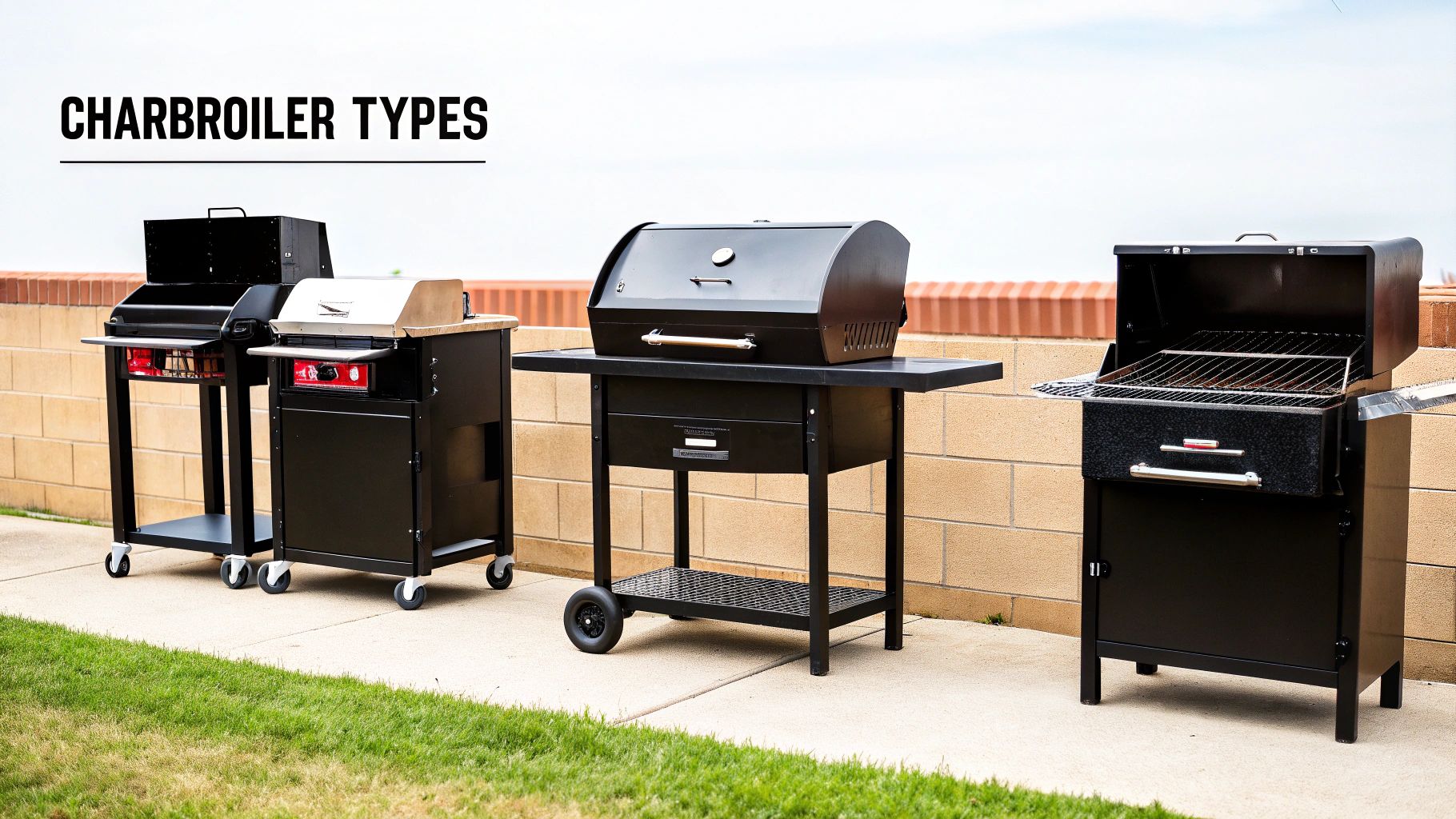
Okay, you've narrowed down your heat source—gas, electric, or infrared. But the real-world performance of a charbroiler comes down to the details. When you're looking through our selection of commercial charbroilers, you have to think beyond the heat and zero in on the features that truly impact how it works, how long it lasts, and how easy it is to use on a chaotic Friday night.
Think of these features as your personal checklist for success. It’s what separates a good purchase from a great investment—one that not only cooks beautifully but also fits right into your kitchen's rhythm and can take a beating day after day.
Construction and Durability
The first thing I look at is what a charbroiler is made of. It tells you almost everything you need to know about its lifespan. You’ll see that most quality commercial units have heavy-duty stainless steel bodies. This isn't just for looks; it's your best defense against rust, corrosion, and the general abuse of a professional kitchen. It also makes cleanup a whole lot less painful.
Then you have the grates—the heart of the machine. They're usually either cast iron or stainless steel. Cast iron is the king of heat retention, giving you those deep, dark sear marks everyone loves, but it needs consistent seasoning to keep rust at bay. Stainless steel is the low-maintenance option; it's much more rust-resistant, though it won't hold onto heat with the same intensity as cast iron.
Grate Design and Functionality
The design of the grates does more than just hold the food; it directly shapes the final product and helps you manage the cooking process. The style you pick can make a huge difference, especially when it comes to grease and flare-ups.
- Rod vs. Cast Grates: Lighter rod grates are a breeze to clean and give you more direct flame contact for that classic char. Heavier cast grates, on the other hand, are heat beasts, providing that powerful, even searing that’s tough to beat.
- Flat vs. Slanted Grates: Flat grates give you that traditional, level grilling surface. But if you’re cooking a lot of fatty items like burgers or ribeyes, slanted grates are a game-changer. They cleverly channel all that excess grease away from the flames and into a collection tray, which dramatically cuts down on flare-ups.
A well-designed grate system is an active partner in the cooking process. It manages heat, creates those iconic grill marks, and helps control flare-ups, giving chefs the consistency they absolutely need during a hectic service.
Operational and Performance Factors
Finally, let's talk about the specs that determine if a charbroiler is actually right for your menu and your space. Getting these right ensures your new machine can keep up from day one. And for a deeper dive, our comprehensive guide to commercial charbroilers for your restaurant walks you through every consideration.
Look at the power rating, measured in BTUs (for gas) or wattage (for electric). A higher number means faster preheating and quicker temperature recovery when you slap a cold steak on the grates—a must-have for high-volume kitchens. You also need to measure your cook line to ensure the unit's physical size fits and gives you enough cooking surface to get through your peak hours.
And one last thing: an effective grease management system is non-negotiable. A large, easy-to-remove drip tray isn't just about making cleaning easier; it's a critical safety feature.
Keeping Your Charbroiler in Prime Condition
Your charbroiler isn't just another piece of equipment; it's the heart of your kitchen, the workhorse behind your most profitable menu items. When you've invested in a machine that delivers those signature smoky flavors, the last thing you want is for it to let you down. Proper care is more than just cleaning—it's protecting your investment.
Consistent maintenance is the secret to keeping your charbroiler cranking out delicious, perfectly cooked food day after day. It prevents those gut-wrenching (and expensive) breakdowns during a dinner rush, keeps your food safe, and ensures the quality your customers count on. A simple routine turns upkeep from a chore into a smart operational habit that pays for itself.
Essential Maintenance Routines
The best way to tackle maintenance without overwhelming your staff is to break it down into daily, weekly, and monthly tasks. This keeps everything manageable and builds a culture of proactive care in your kitchen.
Daily Tasks (End of Shift):
- Scrape the Grates: While the grates are still warm, use a stiff wire brush to knock off all the food residue and carbon. This is the single most important daily step.
- Empty the Grease Trap: This isn't just about cleanliness; it's a critical fire safety measure. Make it a non-negotiable part of your closing checklist.
- Wipe Down Exterior Surfaces: A quick wipe of all the stainless steel surfaces keeps grease from building up and becoming a much bigger job later.
Weekly Tasks:
- Deep Clean Grates: Pull the grates off and let them soak in a commercial-grade degreaser. This is how you get rid of the stubborn, caked-on gunk that daily scraping can't touch.
- Clean Radiants or Briquettes: Gently brush any debris off the radiants or ceramic briquettes. Clean heat sources are the key to even cooking and avoiding frustrating hot spots.
Consistent maintenance is the single best way to avoid common issues like uneven heating and stubborn carbon buildup. A clean charbroiler is a high-performing charbroiler that produces superior food.
For a closer look at how top-tier equipment can power up your kitchen's performance, you can learn how to fire up your business with these commercial charbroilers and see what features make the biggest impact.
Common Questions About Commercial Charbroilers
Even after you get the hang of your charbroiler, a few practical questions always pop up in the heat of a busy service. I've heard these from chefs and owners time and time again, so let's get you some straight answers to help you master your equipment.
Can I Use Wood Chips in a Charbroiler?
This is probably the most common question I get from chefs trying to add that authentic, smoky kiss to their food. While you can’t just scatter wood chips over a gas or electric unit—that's a recipe for a mess and potential damage—some models are built to handle a smoker box accessory.
These are simple metal boxes that hold soaked wood chips and sit right on the radiants, where the heat makes them smolder and release smoke. But it's not a universal feature. You absolutely have to check your manufacturer's guide first. Using an accessory that isn't supported can wreck your charbroiler and void the warranty.
If a deep, consistent smoke flavor is central to your menu, you'd be much better off investing in a dedicated commercial smoker. It's the right tool for that specific job.
What Is the Difference Between a Charbroiler and a Griddle?
Think of it this way: a charbroiler is for grilling, and a griddle is for frying. It's that simple.
A charbroiler has open grates with intense, direct heat blasting up from below. This is what creates those perfect sear marks and lets vaporized drippings infuse the food with that signature smoky flavor.
A flat top griddle, on the other hand, is just a solid, smooth slab of metal. It cooks food with even, direct contact, kind of like a massive skillet.
- Charbroilers are your go-to for grilling steaks, burgers, chicken, and vegetables.
- Griddles are perfect for things that need a flat surface, like eggs, pancakes, bacon, or getting that perfect all-over sear on scallops.
How Often Do Radiants or Briquettes Need Replacing?
The lifespan of your radiants or ceramic briquettes comes down to two things: how much you use them and how well you clean them. In a high-volume kitchen running nonstop, you could be looking at replacing them every 1 to 2 years.
You'll know it's time when you see them cracking, crumbling, or just falling apart. When they start to deteriorate, you'll get uneven heating and hot spots, which is a nightmare for consistency.
The best thing you can do to make them last is to be diligent about cleaning. Don't let grease build up and saturate them. And always, always check your equipment manual for what the manufacturer recommends for a replacement schedule.
At Charbroilers, we know that having the right tool for the job is what separates a good kitchen from a great one. We offer a huge selection of commercial charbroilers to fit any operation, from powerful gas models for high-volume searing and precise electric char broilers for rock-solid consistency, to advanced infrared units that lock in maximum juiciness. Explore our full collection and find the perfect machine to take your menu to the next level at https://charbroilers.com.
